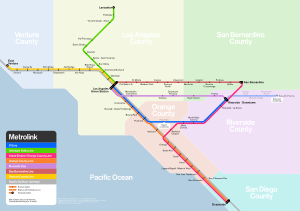Metrolink (California)
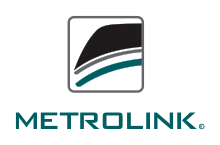 Metrolink logo as of 2017 | |||
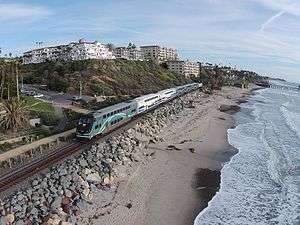 A Metrolink train near San Clemente Pier station | |||
| Overview | |||
|---|---|---|---|
| Locale | Southern California | ||
| Transit type | Commuter rail | ||
| Number of lines | 7[1] | ||
| Number of stations | 62 | ||
| Daily ridership | 39,613 (avg. Q4 2015-16)[1] | ||
| Chief executive | Art Leahy | ||
| Headquarters | MTA Building, Los Angeles | ||
| Website |
www | ||
| Operation | |||
| Began operation | October 26, 1992[2] | ||
| Operator(s) | Amtrak (under contract to the SCRRA) | ||
| Reporting marks | SCAX | ||
| Host railroads | |||
| Character | At-grade and above ground | ||
| Number of vehicles | 52 locomotives, 260 rail cars[1] | ||
| Technical | |||
| System length | 534 mi (859 km) | ||
| Track gauge | 4 ft 8 1⁄2 in (1,435 mm) standard gauge | ||
| Top speed | 90 mph (140 km/h) | ||
| |||
Metrolink (reporting mark SCAX) is a commuter rail system in Southern California consisting of seven lines and 62 stations[3] operating on 534 miles (859 km) of rail network.[4]
The system operates in Los Angeles, Orange, Riverside, San Bernardino, and Ventura counties, as well as to Oceanside in San Diego County.[5][6] It connects with the Los Angeles County Metro Rail and Metro Busway system, the San Diego Coaster commuter rail and Sprinter light rail services, and with Amtrak's Pacific Surfliner, Coast Starlight, Southwest Chief, and Sunset Limited intercity rail services.[7]
The system, founded in 1991 as the Southern California Regional Rail Authority (SCRRA) and adopting "Metrolink" as its moniker,[8] started operation in 1992. Average weekday ridership was 39,838 as of 2017.[4]
Routes
In addition to suburban communities and cities, Metrolink also serves several points of interest such as Downtown Los Angeles, Hollywood Burbank Airport, California State University, Los Angeles, Angel Stadium of Anaheim, and the San Clemente Pier.[3] Special service has also been extended to the Pomona Fairplex,[9] the Ventura County Fairgrounds,[10] and the Auto Club Speedway[11] for certain events.
| Line[5] | Series | Termini | Operation | Routes used[5][6] |
|---|---|---|---|---|
| 91/Perris Valley Line | 700[12] | Los Angeles Perris |
Daily | Southeast from Union Station, east along the Riverside Freeway (State Route 91) to Riverside, then south along Interstate 215. |
| Antelope Valley Line | 200[13] | Los Angeles Lancaster |
Daily | Northwest from Union Station, roughly following Interstate 5. Turns east, then north, to parallel State Route 14. |
| Inland Empire–Orange County Line | 800[14] | San Bernardino Oceanside |
Daily | Southwest from downtown San Bernardino to follow the Riverside Freeway west. Turns south to parallel Interstate 5. |
| Orange County Line | 600[15] | Los Angeles Oceanside |
Daily | Northwest from Oceanside along Interstate 5. Deviates slightly from the interstate in north Orange and southeast Los Angeles counties. |
| Riverside Line | 400[16] | Los Angeles Riverside |
Weekdays | Northwest from downtown Riverside, eventually paralleling State Route 60 along the south Inland Empire. |
| San Bernardino Line | 300[17] | Los Angeles San Bernardino |
Daily | West from downtown San Bernardino between Interstate 10 and I-210. Runs in the Interstate 10 median starting near El Monte. |
| Ventura County Line | 100[18] 900[19] |
Los Angeles East Ventura |
Weekdays | East from Ventura, roughly following State Route 118. Turns south at Hollywood Burbank Airport towards Union Station. Trains with 900-series numbers run between Union Station and Hollywood Burbank Airport. |
Fares
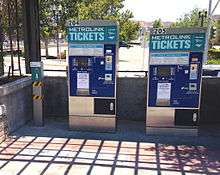
Metrolink's fare structure is based on a flat fee for boarding the train and an additional cost for distance with fares being calculated in 25-cent increments between stations.
Metrolink tickets are valid fare for most connecting buses and trains; certain Metrolink tickets are valid on certain Amtrak routes.[20]
Fare increases normally occur annually in July, to coincide with increased fuel and labor expenses, and have generally averaged between 3.5% and 5% per year (although restructuring caused a larger jump in rates).[21] The oil price increases since 2003 are partly to blame for consistently increasing fares, as Metrolink trains are powered by diesel fuel.[22]
History
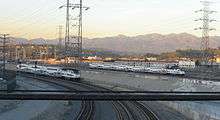
The member agencies of the SCRRA purchased 175 miles (282 km) of track, maintenance yards, and stations and other property from Southern Pacific for $450 million in 1990 ($843 million adjusted for inflation). The rights to use Los Angeles Union Station were purchased from Union Pacific, the station's owner at the time, for $17 million in the same year ($31.8 million adjusted for inflation) (Union Station has since been purchased by the Los Angeles County Metropolitan Transportation Authority).[23][24] The Authority was formally founded in 1991.[25] Amtrak began operation of the Ventura, Santa Clarita (later renamed Antelope Valley), and San Bernardino lines on October 26, 1992 under contract to the SCRRA.[2][26]
In 1993 service was expanded to include the Riverside and Orange County Lines. The Inland Empire-Orange County Line opened in 1995. In 1995 more trains on the Orange County service were funded.[27] The 91 Line opened in 2002.[28]
From July 2004, Metrolink fares were changed from zone based to one based on distance. In 2005 a five-year operational contract was awarded to Connex Railroad/Veolia Transport. In 2005, the Orange County Transportation Authority approved a plan to increase frequencies to 76 trains daily on the Orange County and Inland Empire-Orange County Lines by 2009,[29] and funding for increased Metrolink service was included in the renewal of the Measure M sales tax for transportation approved by voters in November 2006.[30] A proposed station in Yorba Linda was canceled in 2005 due to local opposition.[31]
In July 2008 it was announced that ridership had risen 16% over the previous year.[32][33] Following the 2008 Chatsworth train collision in which 25 people died and 135 were injured a number of safety measures were taken; in the fall of 2009, inward-facing video cameras were installed in locomotives in order to ensure that staff were complying with regulations, in particular a ban on use of mobile phones.[34] In 2010, the first of 117 energy absorbing passenger carriages (which lessen the toll on passengers in the case of an accident) were received by the operator.[35] Amtrak regained the contract to operate Metrolink beginning in July 2010.[36] Average weekday ridership for the fourth quarter of 2009 was 38,400.[32]
In 2010, to save money in the face of funding cuts, the Metrolink board voted to reduce mid-day service on the Inland Empire–Orange County Line, as well as weekend service on both the Orange County and Inland Empire–Orange County lines.[37]
Average weekday ridership was 41,000 during May 2011. A survey found that 90% of users during a typical weekday in 2009 would have previously driven alone or carpooled and that the system replaced an estimated 25,000 vehicle trips.[38] During a weekend closure of Interstate 405 in July 2011 the system recorded its highest-ever weekend ridership of 20,000 boardings which was 50% higher than the same weekend in 2010 and 10% higher than the previous weekend ridership record which occurred during U2 360° Tour in June 2011.[39] Ridership continued to rise in 2012 (up 2%),[38] when average weekday ridership reached 42,265.[38] Although 2013 annual boardings were almost 12.07 million, ridership dropped to 11.74 million by fall 2014 which was contrary to projections. Blaming the decrease on the worst recession since World War II, Metrolink said it found itself caught between cutting service and boosting fares, both of which would probably further decrease ridership.[40]
Metrolink began offering mobile ticketing in early 2016.[41][42][43]
The Riverside County Transportation Commission (RCTC) extended the 91 Line southeast 24 miles (39 km) to Perris, using the existing San Jacinto Branch Line, which it purchased in 1993.[44] Initial plans were for construction/renovation of the line to begin in 2012, but these were delayed by a lawsuit filed by homeowners in the affected area, who challenged the RCTC's environmental report. The lawsuit was settled in late July 2013.[45] Construction on the $248.3 million extension began in October 2013;[46] service was originally planned to begin in December 2015,[47] and then in February 2016.[48][49] In mid-February 2016, the extension's opening was planned in March of that year.[50] The extension opened in June 2016.[51]
Notable incidents
Placentia, April 2002
Two people died and 22 were seriously injured on April 23, 2002, when a BNSF freight train collided head-on with a Metrolink train in Placentia, near the Atwood Junction, at the intersection of Orangethorpe Avenue and Richfield Road. Both trains were on the same east–west track moving toward one another. The Metrolink had the right-of-way; it was supposed to switch to a southbound track. The BNSF train was supposed to slow and stop just before the switch while the Metrolink passed, but the crew missed a signal one and a half miles back warning them to slow down. By the time the crew saw the red "stop" signal at the switch and the Metrolink train, they were going too fast to avoid a collision. Although there was speculation that the signals alerting the BNSF to slow and stop had malfunctioned, an investigation later concluded that it was human error by the crew that caused the accident.[52]
Glendale, January 2005
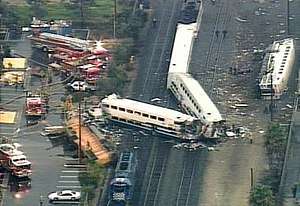
Eleven people were killed (including an off-duty sheriff's deputy and a train conductor) and over 100 people were injured, about 40 seriously on January 26, 2005, when a Metrolink passenger train collided with a vehicle parked on the tracks, which then jackknifed and struck a stationary freight locomotive and a Metrolink train moving in the opposite direction. The man who parked the vehicle on the tracks, Juan Manuel Alvarez, was apprehended and charged with 11 counts of first-degree murder with special circumstances, including murder by train wrecking.[53][54] On June 26, 2008, Alvarez was convicted on the 11 murder counts and sentenced to life imprisonment without the possibility of parole.[55]
Chatsworth (Los Angeles), September 2008
Twenty-six people were killed and 135 injured when a Metrolink commuter train carrying 222 persons[56] collided head on with a Union Pacific freight train, toppling one of the passenger cars and the locomotive onto its side in the Chatsworth district of Los Angeles.[57] Along with the 135 people who were injured, 81 were transported to local hospitals in serious or critical condition.[58] The velocity of the trains caused the Metrolink locomotive to telescope into the first passenger car.[58] Some 218 people have been killed by Metrolink train accidents from 1993 to 2008, a figure which includes pedestrians.[59]
Oxnard, February 2015
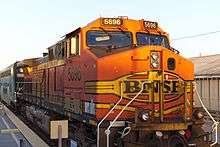
Thirty people were injured when southbound Metrolink Ventura County Line train 102 (East Ventura to LA Union Station) crashed into a truck that was stopped on the tracks at the Rice Avenue crossing near Oxnard at about 5:40 am on February 24, 2015. One person, the train's engineer, later died of his injuries.[60] The driver, who had left the truck before the crash, was located by the police and taken into custody. The train consisted of a Hyundai-Rotem "guardian fleet" cab car in the lead, a Bombardier Bi-level "bike car" coach, two Hyundai-Rotem "guardian fleet" coach cars and an EMD F59PH locomotive. After this accident, Metrolink leased 40 diesel freight locomotives from BNSF, to be placed into service as temporary cab cars while they investigated problems with their Hyundai-Rotem cars. On July 8, 2016, the Metrolink board approved a $1.5 million plan to repair the plows on the Hyundai Rotem cab cars. Once the repairs are completed, the cars will return to service and the leased BNSF locomotives will be returned.[61]
Future
Metrolink has grown in popularity and there are a number of planned extensions of the system and new stations. Station parking capacity has also been strained.[62]
A new Metrolink station in Placentia, which will serve the 91 Line's north Orange County passengers, has completed its final design phase, save for issues related to the parking needed to accompany the station.[63] Construction on the $24 million Placentia station begain in 2018, and is scheduled to open in 2020.[64][65]
The San Bernardino-Redlands Passenger Rail Corridor, a 9-mile (14 km) eastward rail extension from San Bernardino to Redlands and Mentone, is planned by the San Bernardino Associated Governments (SANBAG). The association was considering whether to extend commuter rail along the corridor or to install either bus rapid transit or light rail lines,[66] but in December 2015, SANBAG officials said the planned to extend Metrolink service only to the San Bernardino Transit Center and use diesel multiple units operated by Omnitrans in lieu of Metrolink locomotive-hauled coaches on the rest of the route.[67][68][69] However, Metrolink may provide service to Redlands as part of the extension.[70] The project, budgeted at $242 million, is expected to begin final design in September 2015. Construction is projected to begin in late 2017, with service starting in late 2019.[67]
The Los Angeles County Metropolitan Transportation Authority (Metro) has proposed adding commuter rail service along the Harbor Subdivision corridor offering services to Inglewood, Los Angeles International Airport, the South Bay, the Port of Los Angeles, and/or the Port of Long Beach. A decision whether to employ commuter rail, light rail, or bus rapid transit in this corridor has not yet been reached by the Los Angeles County Metropolitan Transportation Authority.[71]
In 2008, lobbyists pushed for a rail line to Temecula in southwestern Riverside County via the 91 Line's La Sierra station.[72] While this proposed line could follow the route of an abandoned freight line, it would require significant money, as freight service ceased almost 30 years ago. Despite this, the Riverside County Transportation Commission's 2008 Commuter Rail Feasibility Study still lists this route as one possibility being considered.[73] Expansion to Hemet[74] has also been discussed, with two stations planned.[75]
The cities of the Coachella Valley (Palm Springs, Cathedral City, Palm Desert, and Indio) have requested commuter rail service from Los Angeles and Orange County, but the Union Pacific Railroad opposes further passenger service on its tracks.[76] Nonetheless, in 1999, the Coachella Valley Association of Governments was investigating the possibility of two daily round trips via the 91 Line from Los Angeles's Union Station through Fullerton and Riverside to stations in Palm Springs and Indio (with a possible stop near Palm Desert),[77] possibly through a partnership with Amtrak. This extension would likewise require significant money for infrastructure improvements: at least $500 million, according to the California State Rail Plan of 2005.[76] Nonetheless, in 2013 Caltrans conducted a feasibility study of a Coachella Valley service[78] and RCTC has resolved to pursue establishing one.[79]
Expansion to Kern County has been discussed in a 2012 Kern County Council of Governments report.[80][81]
High speed rail interface
During the initial years of operation of the California High-Speed Rail between Merced and Burbank, projected to commence in 2022, passengers would use Metrolink for travel between Burbank and downtown Los Angeles. An alternative plan would have track-sharing to Union Station but this would require electrification for that portion of the line. This alternate plan would provide a "one-seat ride" at the start of service between the Central Valley and downtown, or even Orange County.[82]
Governance

The SCRRA is a joint powers authority governed by five county-level agencies: the Los Angeles County Metropolitan Transportation Authority, the Orange County Transportation Authority, the Riverside County Transportation Commission, the San Bernardino Associated Governments, and the Ventura County Transportation Commission.[25] Ex officio members include the Southern California Association of Governments, the San Diego Association of Governments, and the state of California.[1]
Metrolink's headquarters at one time were in the MCI Center.[83] By 2000, Metrolink had expanded its lease in the MCI Center by 6,700 square feet (620 m2), giving the agency a total of around 40,000 square feet (3,700 m2) of space.[84] In June 2011, Metrolink moved its headquarters to the MTA Building,[85] where the Los Angeles County Metropolitan Transportation Authority (LACMTA) is also headquartered. Metrolink will move to the Wilshire Grand Center in 2018 along with the Southern California Association of Governments.[86][87] The move was precipitated by LACMTA requiring more space in the MTA Building.[87]
In 2014, an internal report suggested changes in the railroad's governing structure as the conflicting demands of the various agencies are difficult to meet. The report proposed turning the operation over to a local transit agency.[88]
Facilities
Metrolink operates several maintenance facilities across its service area. Its Central Maintenance Facility (CMF) is located on the east bank of the Los Angeles River near the intersection of the 5 and 110 Freeways, just south of the location of the former Southern Pacific Taylor Yard.[89] The facility is operated by Metrolink's equipment maintenance contractor: Bombardier Transportation.[90] The nearby Eastern Maintenance Facility is located in San Bernardino. Metrolink trains are also serviced at Coaster's Stuart Mesa Facility, which is located between San Clemente Pier and Oceanside at the southwest end of Camp Pendleton. This yard is owned by the North County Transit District.[90]
Metrolink's operations center is located in Pomona, near the Pomona (North) station.[91]
Rolling stock
The Metrolink fleet consists of 52 locomotives,[1] 137 active Bombardier Bi-level Coaches (Sentinel Fleet), and 137 Hyundai Rotem Bi-level cars (Guardian Fleet).[92]
Livery
Most Metrolink-owned units are painted in a white livery with blue stripes that was introduced in the late 1990s as a replacement for a similar scheme that had been in use since the agency's launch. The agency is currently in the process of switching to a new blue and green "ribbons" design since the proposed change in 2007. Locomotives are being given the updated design during routine maintenance, and the Guardian Fleet and EMD F125 locomotives arrive from the factory in the new colors.[36][93]
See also
- Transportation in San Diego County
- Transportation in Los Angeles
- Hal Bernson, former Metrolink chairman
References
- 1 2 3 4 5 "Southern California Regional Rail Authority's Fact Sheet" (PDF). Metrolink. 2016. Archived from the original (pdf) on August 28, 2017. Retrieved October 21, 2016.
- 1 2 "Metrolink 20th Anniversary Report". Metrolink. Retrieved August 14, 2013.
- 1 2 "Train Stations". Southern California Regional Rail Authority. Archived from the original on January 1, 2018. Retrieved January 1, 2018.
- 1 2 "Facts and Numbers". Southern California Regional Rail Authority. Retrieved November 14, 2017.
- 1 2 3 "Timetable" (PDF). Metrolink. 2018. Retrieved June 30, 2018.
- 1 2 "Metrolink - How 2 Ride Guide - Southern California System Map" (pdf). American Automobile Association (AAA). Retrieved August 14, 2013.
- ↑ "Los Angeles". Amtrak California. Archived from the original on March 27, 2010. Retrieved March 28, 2010.
- ↑ "History of Metrolink". Southern California Regional Rail Authority. Retrieved November 9, 2017.
- ↑ "Metrolink to Make Special Stops at Fair". Metrolink. Retrieved April 3, 2010.
- ↑ "Metrolink to Again Offer Service to Ventura County Fair". Metrolink. Retrieved April 3, 2010.
- ↑ "Take Metrolink to the Auto Club Speedway for NASCAR Action!". Metrolink. Retrieved April 3, 2010.
- ↑ "91 Line". Metrolink. Retrieved March 31, 2010.
- ↑ "Antelope Line". Metrolink. Retrieved March 31, 2010.
- ↑ "Inland Empire-Orange County Line". Metrolink. Retrieved March 31, 2010.
- ↑ "Orange County Line". Metrolink. Retrieved March 31, 2010.
- ↑ "Riverside Line". Metrolink. Retrieved March 31, 2010.
- ↑ "San Bernardino Line". Metrolink. Retrieved March 31, 2010.
- ↑ "Ventura County Line". Metrolink. Retrieved March 31, 2010.
- ↑ "Burbank-Bob Hope Airport Line". Metrolink. Retrieved March 31, 2010.
- ↑ "Metrolink Considering Raising Fares Due to Higher Fuel Costs". Metrolink. April 26, 2005. Retrieved March 27, 2010.
- ↑ "Metrolink Board approves increase to systemwide and Group Travel Program fares". Metrolink. April 25, 2008. Retrieved March 27, 2010.
- ↑ "EZ transit pass program". Metrolink. Retrieved March 27, 2010.
- ↑ "LACTC to acquire Union Pacific property and trackage rights for planned five-county commuter rail system. (Los Angeles County Transportation Commission)". Southern California Business. September 1, 1991. Retrieved March 28, 2010.
- ↑ Middleton, William D. (November 1, 1992). "California gets it together. (rail systems)". RailwayAge. Retrieved March 28, 2010.
- 1 2 "EXPERIENCE METROLINK'S HISTORY". Metrolink. Retrieved June 11, 2018.
- ↑ "Metrolink Train Service Begins Monday, Oct. 26". The Free Library. October 22, 1992. Retrieved April 2, 2010.
- ↑ Berkman, Leslie (July 14, 1995). "Metrolink Adds 2 More Trains Per Day for Orange County". Los Angeles Times. Retrieved March 27, 2010.
- ↑ "Metrolink Milestones". Metrolink. Retrieved March 27, 2010.
- ↑ Radcliffe, Jim (November 14, 2005). "Metrolink daily O.C. service to nearly double". Orange County Register.
- ↑ "Measure M2". Orange County Transportation Authority. Archived from the original on June 12, 2010. Retrieved March 27, 2010.
- ↑ Pang, Kevin (March 17, 2004) "Yorba Linda Rejects Train Station Plan" Los Angeles Times
- 1 2 "Public Transportation Ridership Report: Fourth Quarter 2009" (pdf). American Public Transportation Association. March 2, 2010. p. 5. Retrieved March 25, 2010.
- ↑ Hymon, Steve (August 2008). "Metrolink sets ridership record, candidates don't talk traffic and sales tax: Ramping up, August 18". Los Angeles Times.
- ↑ Willon, Phil (October 6, 2009). "Metrolink adds video cameras to locomotives". Los Angeles Times.
- ↑ Groff, Joann (March 12, 2010). "Metrolink receives passenger cars specially designed to absorb a crash". Camarillo Acorn. Archived from the original on July 16, 2011. Retrieved April 2, 2010.
- 1 2 "Metrolink Matters" (pdf). Metrolink. March–April 2010. Retrieved March 25, 2010.
- ↑ Connell, Rich (January 8, 2010). "Metrolink cuts some weekend trains, but fares stay put". Los Angeles Times. Retrieved March 26, 2010.
- 1 2 3 "Southern California Regional Rail Authority's Fact Sheet" (PDF). Metrolink. 2012. Archived from the original (PDF) on May 31, 2013. Retrieved August 14, 2013.
- ↑ "Metrolink sets weekend ridership recording during 405 closure". The Source. Retrieved July 21, 2011.
- ↑ Weikel, Dan (September 7, 2014) "Metrolink's annual ridership continues to drop" Los Angeles Times
- ↑ Worrell, Carolina (March 14, 2016). "Metrolink launches mobile ticketing app". Railway Age. Archived from the original on March 15, 2016. Retrieved March 19, 2016.
- ↑ "Metrolink board approves purchase of mobile ticketing technology" (Press release). Metrolink. January 15, 2016. Archived from the original on March 10, 2016. Retrieved March 5, 2016.
- ↑ "Metrolink wants to turn your smartphone into a ticket". San Gabriel Valley Tribune. April 1, 2016. Retrieved November 9, 2017.
- ↑ "Perris Valley Line Project Description". Riverside County Transportation Commission (RCTC). Retrieved February 3, 2014.
- ↑ Downey, David (July 30, 2013). "PERRIS VALLEY LINE: Judge signs off on settlement". The Press-Enterprise. Retrieved August 10, 2013.
- ↑ "Perris Valley Line". Riverside County Transportation Commission. Archived from the original on December 19, 2015. Retrieved May 9, 2015.
- ↑ Downey, David (September 14, 2014). "Transportation: Perris Valley Line taking shape". The Press-Enterprise. Retrieved May 9, 2015.
- ↑ Weikel, Dan (December 11, 2015). "Metrolink expansion to Perris is dedicated ahead of its 2016 opening". Los Angeles Times. Retrieved December 13, 2015.
- ↑ Sheridan, Tom (December 11, 2015). "PERRIS: Perris Valley Line welcomed in style; service to begin in February". The Press-Enterprise. Retrieved December 13, 2015.
- ↑ http://www.pe.com/articles/testing-794263-trains-officials.html
- ↑ Sheridan, Tom (June 6, 2016). "TRANSPORTATION: Perris Valley Line rolls out right on schedule". The Press-Enterprise. Retrieved June 6, 2016.
- ↑ "Railroad Accident Report- Collision of Burlington Northern Santa Fe Freight Train With Metrolink Passenger Train- Placentia, California- April 23, 2002" (PDF). National Transportation Safety Board. October 7, 2003. Retrieved November 22, 2005.
- ↑ Muskal, Michael; Sanchez, Jesus (January 26, 2005). "Man Faces Charges in Metrolink Collision". Los Angeles Times. Retrieved April 2, 2010.
- ↑ Simmons, Ann M.; Leonard, Jack (June 27, 2008). "Verdict in train wreck: murder". Los Angeles Times. Retrieved April 2, 2010.
- ↑ Simmons, Ann M. (August 21, 2008). "Metrolink killer gets 11 life terms, no parole". Los Angeles Times. Retrieved April 2, 2010.
- ↑ "Commuters killed in head-on train crash". KABC-TV. September 12, 2008. Retrieved September 12, 2008.
- ↑ Hymon, Steve; Oldham, Jennifer; Simmons, Ann M. (September 16, 2008). "L.A. train crash death toll at 26". Chicago Tribune. Retrieved April 2, 2010.
- 1 2 "Death toll from L.A. train collision reaches 25". Associated Press. September 13, 2008. Retrieved September 13, 2008.
- ↑ "Metrolink has 218 deaths in 15 years". U-T San Diego. September 28, 2009. Retrieved February 24, 2015.
- ↑ "Metrolink train crash: more than 30 injuries, driver involved in custody". KABC-TV. February 25, 2015. Retrieved March 26, 2015.
- ↑ "Metrolink approves $1.5 million to repair defective cab cars". Los Angeles Times. July 8, 2016. Retrieved July 9, 2016.
- ↑ Reyes, David (July 5, 2008). "Metrolink growth strains station parking capacity". The Los Angeles Times. Retrieved July 7, 2008.
- ↑ "Old Town Santa Fe District Metrolink Station". City of Placentia. Retrieved May 9, 2015.
- ↑ "Metrolink Station and Parking Structure". City of Placentia. Retrieved September 21, 2016.
- ↑ "Placentia Metrolink Station" (pdf). Orange County Transportation Authority. January 28, 2009. Retrieved March 27, 2010.
- ↑ "Downtown San Bernardino and Redlands Passenger Rail Projects". San Bernardino Associated Governments. July 11, 2013. Archived from the original on February 5, 2012. Retrieved August 12, 2013.
- 1 2 Emerson, Sandra (May 6, 2015). "Redlands City Council updated on Redlands Passenger Rail project". Redlands Daily Facts. Retrieved May 9, 2015.
- ↑ http://www.sbsun.com/general-news/20150908/san-bernardino-transit-center-opening-makes-commuting-easier
- ↑ "Archived copy" (PDF). Archived from the original (PDF) on December 22, 2015. Retrieved June 2, 2016.
- ↑ Emerson, Sandra (August 19, 2016). "Where Redlands rail project is heading". The Press-Enterprise. Retrieved April 19, 2017.
- ↑ "Metro Harbor Subdivision Transit Corridor Alternatives Analysis Report – Final" (pdf). Los Angeles County Metropolitan Transportation Authority. November 2009. Retrieved March 25, 2010.
- ↑ "I-15 Commuter Rail Feasibility Study" (pdf). Wilbur Smith Associates. June 29, 2007. Retrieved January 20, 2014.
- ↑ "2008 Commuter Rail Feasibility Study". Riverside County Transportation Commission. 2008. Retrieved February 2, 2014.
- ↑ https://www.pe.com/2017/07/29/economic-driver-or-trouble-magnet-transportation-leaders-back-hemet-mobility-hub/
- ↑ https://www.cityofhemet.org/DocumentCenter/View/4513
- 1 2 "Coachella Valley Rail Service". Riverside County Transportation Commission. Retrieved February 3, 2014.
- ↑ "Coachella Valley Passenger Rail Feasibility Study" (PDF). Schiermeyer Consulting Services. February 1999. Archived from the original (pdf) on December 23, 2008. Retrieved March 27, 2010.
- ↑ "Coachella Valley Intercity Rail Corridor Planning Study" (pdf). AECOM. May 2013. Retrieved January 20, 2014.
- ↑ "RCTC Resolution 13-042 to Establish Daily Intercity Rail Service" (pdf). Riverside County Transportation Commission. October 2013. Retrieved January 20, 2014.
- ↑ http://www.kerncog.org/wp-content/uploads/2010/03/KernCOG_Commuter_Rail_Draft_Report_20120720.pdf
- ↑ http://scagrtpscs.net/Documents/2016/proposed/pf2016RTPSCS_PassengerRail.pdf
- ↑ "Bullet train's eventual link to L.A. rail system far from clear-cut" Los Angeles Times
- ↑ "Contact Us". Metrolink. Retrieved March 18, 2010.
- ↑ "Commercial Real Estate; Deals". Los Angeles Times. October 3, 2000. p. 10. Retrieved April 5, 2010 – via ProQuest Archivermd-all.
- ↑ "Metrolink Matters" (pdf). Metrolink. June 2011. p. 2.
- ↑ Solomon, Daina Beth (June 30, 2017). "Buzz About Potential Lease Deals at Wilshire Grand". Los Angeles Business Journal. Retrieved November 14, 2017.
- 1 2 Hoberman, Natalie (November 8, 2017). "Metrolink inks deal for 30K sf at Wilshire Grand". The Real Deal Los Angeles. Korangy Publishing. Retrieved November 14, 2017.
- ↑ Weikel, Dan (December 12, 2014) "Metrolink chief Michael P. DePallo quits after two years" Los Angeles Times
- ↑ "Taylor Yard History". The River Project. Archived from the original on May 26, 2009. Retrieved March 27, 2010.
- 1 2 "Bombardier Transportation in the USA". Bombardier. Retrieved March 27, 2010.
- ↑ http://www.dailynews.com/article/ZZ/20090818/NEWS/908189899
- ↑ http://metrolink.granicus.com/DocumentViewer.php?file=metrolink_0e45aa65088f01bf84c11a7cb31dab4b.pdf&view=1
- ↑ Connell, Rich (May 3, 2010). "Metrolink's crash-resistant cars are unveiled". Los Angeles Times. Retrieved May 6, 2010.
External links
Route map:
| Wikimedia Commons has media related to Metrolink (Southern California). |
- Official website
- Metrolink service updates on Twitter

- Metrolink at the Los Angeles County Metropolitan Transportation Authority website
- Metrolink at the Orange County Transportation Authority website
- Metrolink at the Riverside County Transportation Commission website
- Metrolink at the San Bernardino Associated Governments website
- Metrolink at the Ventura County Transportation Commission website
